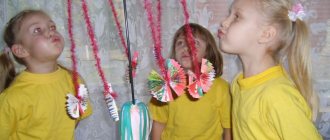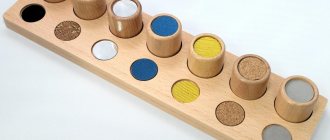Methodology for introducing preschoolers to the work of adults
Features of working in a junior preschool group
In the younger group, there are no special classes to educate the attitude towards a hard worker. This problem is solved in everyday life: observing the work of adults, in art classes, when reading works of fiction, looking at paintings and illustrations for books. Thus, when organizing observations of the work of adults, the teacher each time thinks through techniques that will help children develop a friendly attitude towards the hard worker. These techniques are varied: general conversation, involvement in an adult’s activity, memorization of a separate poem, etc.[7].
For educational purposes, the teacher uses literature in which numerous images of adults (mothers, grandmothers) evoke a feeling of sympathy. Works of fiction teach us to be attentive, caring, and friendly towards other people. For example, children are read the story “My Mother” (from the series “My Family”) by the Bulgarian writer Dora Gabe. After reading this story, the teacher asks the kids to remember what words the writer uses to talk about their mother. Children are led to the answer that “mother is kind, good, cheerful, loves her children.” Then the teacher talks about mothers in general, what they do at home, at work, who they care for and how they care.
Introducing children to the work of a janitor, driver, cook, doctor, that is, those people who work directly in kindergarten and whom children know well, you can use B. Zakhoder’s poems “Driver”, “Shoemaker”, A. Kordamova during the conversation. Our doctor" (in excerpts). Children quickly remember these verses. Thanks to them, kids learn that a doctor is a kind and brave person, he helps children if they get sick. You can also talk about the kindergarten doctor, nurse, or other doctors the children know. Gradually, the kids are, as it were, “taken” outside the kindergarten and family. They learn that there are many janitors, drivers, doctors, and teachers; they work in different places. It’s good if the janitor, driver, cook, whom the children recently met, come to the group to see how the children live. The kids will be delighted by the arrival of such guests. It will cause them a new wave of positive emotions.
Thus, it is necessary to begin labor education of children in early preschool childhood. In this case, the main means should be to introduce people who are difficult for the child to know: mothers, grandmothers, grandfathers, etc.
Features of working in the middle group of kindergarten
In the middle group, work to familiarize adults with labor and cultivate a positive attitude towards workers continues. Children of this age are independent, they have more advanced work skills compared to children, their feelings and relationships are more conscious, their interest in the life around them is broader, and their understanding of the work of kindergarten staff (music worker, teacher) is richer. All this allows us to somewhat change the nature of pedagogical work, both in content and form.
In the middle group, several new topics are being developed: “About how our mothers and fathers work,” “Who works on the farm,” “About the work of people in transport professions,” “About the work of builders.” The teacher tells the children about the content of work and its social significance. However, a story about professions becomes pedagogically significant if, when explaining the content of work, the teacher focuses not on the specification of the process, but on the person, his business and personal qualities, that is, directly or through fiction, he introduces children to a person of a certain profession. At the same time, attention is drawn to how adults conscientiously and responsibly carry out their duties, how they treat the results of work and materials with care: it speaks of the kindness, friendliness, willingness to help, and cheerfulness of a working person.
When covering each topic, the teacher thinks through two aspects: familiarization with the content of work and familiarization with the business and personal qualities of a working person[8]. For example, the topic: “About the work of builders.” Program objective: To introduce children to the work of people in construction professions: mason, painter, roofer, etc. Foster interest and respect for their work. Expanding on the topic “About the work of builders,” the teacher uses the poems of A. Brodsky “My Brother” and S. Baruzdin “Who Built This House?” It is advisable to read the last poem after the children have been on an excursion to a house under construction and have gained an idea of the work of construction workers. In this case, they perceive poetry more emotionally.
Poems by S. Baruzdin “Who built this house?” similarly analyzed in the older group. For children in the middle group, it is enough to ask the question: “Who do you think built the house in which we live?” There is no need to ensure that students list all construction professions. It is especially emphasized that the house is being built quickly thanks to the friendship of the builders, and that people are happy about their new houses.
Thus, in the middle group of kindergarten, work continues to familiarize adults with labor and cultivate a positive attitude towards the worker. At the same time, it is necessary not only to acquaint children with the content of work, but also to reveal the personal qualities of a person - a worker.
Lesson notes for junior group 2 “What professions are there?”
Lesson notes for junior group 2 “What professions are there?”
Goal: To introduce children to various professions.
Tasks:
Educational:
1. Cultivate friendly relationships;
2. Cultivate interest in various types of professions.
Educational:
1. Arouse respect and the desire to imitate adults, work constantly and conscientiously.
2. Encourage children to talk about the work activities of professions familiar to them (doctor, hairdresser, builder, cook)
Educational:
1. Develop speech, auditory perception, communication skills;
2. Develop the ability to answer in complete, common sentences, observation, intelligence, and attention.
Preliminary work:
Conversations about professions, looking at illustrations on the topic, looking at tools of different professions, reading fiction.
Materials and equipment: pictures “Professions”, baskets with vegetables and fruits, first aid kit, bandage, thermometer, syringe, comb, scissors, saucepan, ladle, hammer, screwdriver, steering wheel, keys.
Progress:
I. Introductory part
1. Organizational moment ( bell, tambourine
)
There's a knock on the door. The postman sent a letter from Masha.
Educator:
Guys, postman Pechkin sent a letter, who is it from.
( from Masha)
Educator:
What is Masha writing to us?
Hello guys, I was cleaning out the table at Mishka’s house and found interesting pictures in one of the drawers, they depict people in different clothes, I don’t understand who they are, help me figure it out.
Educator:
Guys, let's help Masha find out who is shown here in the pictures?
Educator:
(
looks at the pictures
). Wow, people of different professions are drawn here. Guys, what professions do you know? (cook, driver, hairdresser, etc.)
Educator:
Well done, now let's see what professions Masha has in the pictures.
II. Main part
1. Conversation based on illustrations. (The teacher puts out the first card)
Educator:
Children, look at the picture and tell me, what profession is the person depicted?
(cook)
Well done, now Vasilisa will tell us a poem about the cook.
Vasilisa:
The cook will prepare cutlets for us,
The cake will also bake meatloaves.
It's like a magician works in the kitchen,
Everyone will have a great appetite.
Educator: -
What does the cook do?
(cooking)
- What’s cooking? (Cooks soup, compote; fries cutlets (fish or meat, scrambled eggs; bakes casseroles; makes salads; bakes pies)
— What does he have in the kitchen? (pots, knives, stove).
— Do we have a cook in the d/s?
Educator:
Let's play cooks.
( Kirill, Polina
)
Game "What's for what?" The teacher places two pots and a basket of vegetables and fruits (dummies) in front of the picture. It turns out 2 children
.
Educator:
Here are two pans.
In one we will select products for compote, and in the other we will select products for soup .
Educator:
Well done boys. They did an excellent job.
The teacher displays a picture.
Educator:
Who is shown in the picture?
(Hairdresser)
Well done, now Eva will tell us a poem about a hairdresser.
Eve:
Who's the hairdresser today? Let me be there.
I'll do your hair, for example, like mine.
Sit in front of the mirror, I'll tie the cape
And, of course, first of all, I’ll comb my hair carefully.
Educator:
Who did Eva tell the poem about?
(About the hairdresser
)
— What does a hairdresser do? ( Cuts hair, dyes hair, does beautiful hairstyles).
And what tools does a hairdresser need to cut hair and do hairstyles?
( Scissors, comb, hair dryer)
I see you are already tired. It's time for us to get some rest. Let's go for a ride in the car.
Physical school
“We’re going, we’re driving a car, (driving movements)
We press the pedal. (legs bent, knees extended)
Turn the gas on and off (turn the lever toward you, away from you)
We look intently into the distance. (palm to forehead)
Wipers count the drops
Left, right. Purity! (waving palms)
The wind will ruffle your hair. (ruffle hair with fingers)
We are drivers anywhere!” (right thumb up)
Educator:
Well done! We made good drivers.
The teacher displays a picture.
Educator:
Guys, who is shown in this picture?
(doctor)
Well done, now Nastya will tell us a poem about a doctor.
Nastya:
If your ear hurts,
If your throat becomes dry.
Don't worry and don't cry -
After all, the doctor will help you.
Educator:
Where does the doctor work?
( in the hospital)
-What is he doing? (Treats patients, measures temperature, gives an injection, listens to the heart, prescribes medicine)
Game “Doctor’s Suitcase” There are objects on the table (pills, apple, etc.)
Educator:
Children, you and I need to help pack a suitcase for the doctor, what will we take with us, and what will be unnecessary?
(Gleb, Varya)
Educator:
Well done boys. They did an excellent job.
The teacher displays a picture
Educator: Well done, guys! Next picture. Who is depicted on it? (Builder)
Well done, now Misha will tell us a poem about a builder
Misha:
He puts the bricks in a row,
He is building a kindergarten for the children.
Not a miner or a driver,
A builder will build a house for us.
Educator
: Who did Misha tell the poem about?
(About the builder)
- What does the builder do? (Builds a house, school, kindergarten, garage, fence, gate)
Educator: Is a builder a necessary profession? Well done boys!
Game “Who needs what” (Prepare supplies in a bag for each profession . Children take out from the bag items that are necessary for a particular activity. For the subject, children must name the profession in which the item is used. (saucepan, ladle, scissors, hairdryer , hammer, screwdriver, thermometer, syringe, steering wheel, keys.)
Educator
: Guys, I have a magic bag here, it contains different items, you need to determine what profession the person needs this item.
III. Final part. Reflection.
Educator:
Guys, you all did well today, and most importantly, we helped Masha find out who was drawn in the pictures that she found in Mishka’s desk. Let's remember what professions we met: doctor, driver, cook, builder, hairdresser. All professions are important and needed. Thanks to all.







